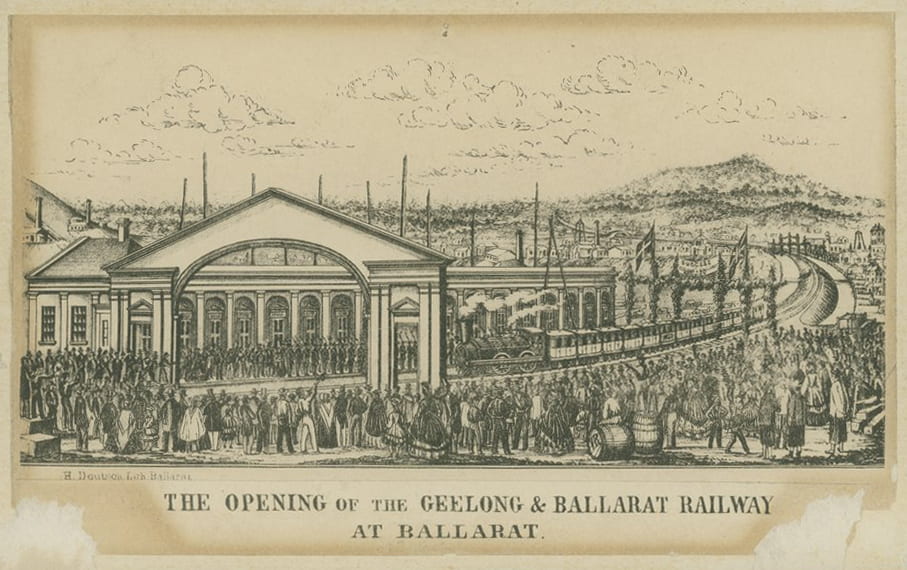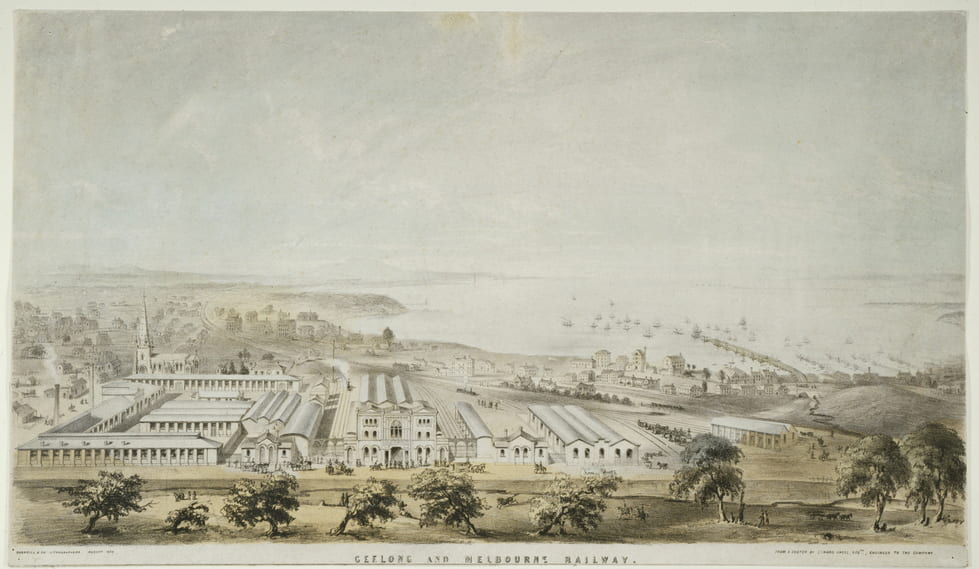
Building Rail, Building Victoria: A History of the Melbourne–Geelong Railway
Trains and railroads hold a curious appeal for many of us, and they make compelling subjects for historical research. In 2018, History major Tim Lilley chose to produce his third-year capstone research project on the history of the Melbourne-Geelong railway. We showcase his outstanding project here, in the first of a series of posts spotlighting some of the best work produced by undergraduate History students at Melbourne.
In their third year, History majors at Melbourne produce a major independent research project for the capstone subject ‘Making History’. This gives students the chance to test out the historical skills they have developed throughout the course of their degree, applying them to a topic of their own choice.
We also encourage them to think beyond the traditional research essay format for this project. Ideally, we want them to produce something that will have life beyond the end of semester, and that will reach wider audiences, beyond their tutor or their lecturer. Students are free to experiment with using digital and other media to communicate their research in creative ways.
Tim Lilley was one of a number of students who chose to produce a video documentary for the capstone project. The result is not just an excellent work of railway history, but a vivid illustration of the ways in which studying history can deepen our attachment to place, and lead us to look at the everyday world around us in new ways.
Tim reflects below on the experience of producing this project – on developing his voice as a historian, and also on the nitty gritty of creating the documentary. You can watch the full documentary in video at the end of the post.

I studied a diverse range of history subjects in third year, but I found my historical niche in my research project for the History Capstone. For my project, I researched and produced a video documentary about the history of the Melbourne-Geelong Railway, from its opening in the 1850s through to the beginning of the automobile era in the 1920s.
This topic arose out of my lifelong love for trains and my identity as someone who lives in Melbourne’s west. Although Australian railway historiography has meticulously documented the minutiae of Victoria’s trains and railroads, I chose to take a more contemporary approach, focusing on the broader economic and social history of the railways. I was also interested not just in the history of the construction of the railway itself, but in how the railway changed and shaped people’s lives. So one of my primary aims was to investigate how the railway line contributed to the development both of local communities along its path and of Victoria as a whole.
What I found was that in the short term, the Melbourne-Geelong line failed to achieve the lofty goals of the Geelong capitalists who built it. In fact, their plan may have backfired, because the new railway actually drained traffic away to Melbourne. However, in the long term, the railway played a crucial role in the nineteenth-century processes of industrialisation and colonisation in Victoria. It became a vital trunk railway, fostering connections across Victoria’s west and contributing to urban and suburban growth – albeit in complicated, sometimes unexpected and inconsistent ways. Overall, it was clear that Victoria was not just building rail – rail was building Victoria.
My workshop stream for the Capstone – Histories in Public – was all about communicating historical research to non-academics. I decided that a video documentary would be an ideal format to make the project accessible and engaging. Railway history is a popular topic, and it’s also a topic that is often of great interest for local communities. Presenting my research in video form would potentially enable me to reach people who might not want to read an academic essay, but would be happy to watch a documentary.
I started by visiting the Newport Railway Museum, where I received some inspiration from Ian Jenkin, the Australian Railway Historical Society Victorian Branch’s Vice President. Next, I collected sources in a variety of libraries and archives, including the University of Melbourne libraries, the State Library of Victoria (SLV), Hobsons Bay Libraries and the University of Melbourne Archives. I also brought an oral history component to the documentary by interviewing Ian Jenkin at the Museum, providing some interesting flourishes for my project.

After writing and editing my script, I spent a day filming at various sites along the Melbourne-Geelong line with the help of my friend Alain Nguyen, an amateur photographer. I recorded the remaining narrative using my iPhone’s Voice Memos app, and collected various photos and videos for my documentary from sources including the SLV’s digital image pool, Trove, and YouTube, before finally putting the video together using Adobe Premiere Pro.
I found making a documentary for the first time quite challenging. It took far longer to put together than I initially expected, especially as I had to learn how to use new software. There were various stumbling blocks along the way: I was harassed by windy weather on filming day, and had to re-record sections due to pronunciation errors. I had to learn how to adjust the speed of my speech – at first I drastically over-estimated the number of words you can speak per minute and still stay comprehensible. Finding suitable high-quality images also presented a challenge – most nineteenth-century images don’t meet the required standards on this front. All in all, this was a steep learning curve, and an exceptionally educational experience, in the course of which I learnt a great deal about railways, filmmaking, and making public history.
Doing the project motivated me to seek deeper knowledge about the local history of my area, the western suburbs of Melbourne. It helped to inspire the topics for the Honours thesis I’m working on this year: a local history of the Yalukit Willam people of Melbourne, under the supervision of Associate Professor Sara Wills. The Yalukit Willam are one of the six clans of the Boon Wurrung people of Melbourne, and their land was centred on the coastal strip between the Werribee River and St Kilda, which today includes such suburbs as Point Cook, Altona, Williamstown, Port Melbourne, South Melbourne, and Prahran.
My project will detail the story of the Yalukit Willam’s relations with the British colonists during the colonial era, with the aim of offering local nuance to dominant historical narratives. For instance, I’m studying the Yalukit Willam Arweet Derrimut’s crucial warning to the settlers at Melbourne of an impending attack from another Indigenous clan in October 1835 – an example of the Yalukit Willam’s efforts to foster good relations with the strange white men from across the sea, that can easily be forgotten with the wider narrative of colonial violence.
I’m really grateful for the many opportunities that studying at Melbourne has offered for broadening my mind while learning about histories that matter to me.
For this and other superb work produced last year, Tim Lilley received the 2018 R.G. Wilson Scholarship, awarded to the best third-year History student. The scholarship was established in honour of Robert Garrick Wilson, grocer, wine and spirit merchant of Swanston Street, by his wife, Annie, who left £2000 to the University for this purpose in 1916.
The 2018 History capstone teaching team was led by Professor David Goodman, together with Professor Mark Edele and Dr Julie Fedor, and supported by a group of experienced and dedicated tutors: Joel Barnes, Sarah Craze, Nicole Davis, and Roly Wettenhall.
The ‘Histories in Public’ capstone workshop, within which Tim’s project was produced, was run by Professor David Goodman and Nicole Davis.
Tim Lilley extends his thanks to Ian Jenkin (Australian Railway Historical Society (ARHS) Victorian Branch Vice President); Alain Nguyen (Videographer); the ARHS Newport Railway Museum; and Metro Trains Melbourne.